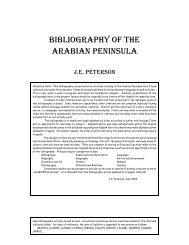THE ARABIAN PENINSULA IN MODERN TIMES: A - JEPeterson.net
THE ARABIAN PENINSULA IN MODERN TIMES: A - JEPeterson.net
THE ARABIAN PENINSULA IN MODERN TIMES: A - JEPeterson.net
You also want an ePaper? Increase the reach of your titles
YUMPU automatically turns print PDFs into web optimized ePapers that Google loves.
Khalid al‐Dakhil, Michael Cook, Guido Steinberg, Abdulaziz al‐Fahad, and David Commins. 75 In<br />
addition, Hala Fattah has explored the Wahhabi influence in Iraq, Abdulla Zaid has studied the<br />
Ikhwan (the harnessing of the tribes of the Najd as the flying wings of the Saudi expansionism<br />
before being crushed by King ‘Abd al‐‘Aziz), and Yaroslav Trofimov gives a detailed account of<br />
the takeover of the Great Mosque of Makkah in 1979 by descendants of the Ikhwan, also called<br />
Neo‐Ikhwan. 76<br />
Islamic Sects and Minorities. Other scholars have worked on the Shi‘ah and other Islamic<br />
sects. Studies of the Ja‘faris (or Ithna‘asharis; Twelver Shi‘ah) predominate, with Laurence<br />
Louër providing a view throughout the Gulf, Guido Steinberg investigating the Shi‘ah of Saudi<br />
Arabia’s Eastern Province (now numbering perhaps one million), Werner Ende illuminating the<br />
little‐known Nakhawilah community of al‐Madinah, and Fouad Ibrahim tracing the rise of Shi‘ah<br />
political opposition in the Eastern Province. Mark Sedgwick also provides a look at Sufism in al‐<br />
Hijaz earlier in the 20 th century. 77 Amongst other studies of Islamic sects, Gabriele vom Bruck<br />
has tackled the centrality of the Zaydi (Fiver Shi‘ah) imamate in Yemen, S. Jiwa discusses<br />
Isma‘ilis (Sevener Shi‘ah) in Yemen, and Valerie Hoffman throws light on Ibadism in Oman and<br />
Zanzibar. 78<br />
Popular Topics<br />
There remains a body of work that might be given, for lack of a better term, the title of<br />
“Popular Topics” because of the numbers of studies and scholars devoted to two fields relating<br />
75. Michael Cook, “On the Origins of Wahhabism,” Journal of the Royal Asiatic Society, 3rd Series, Vol. 2, Pt. 2<br />
(July 1992), pp. 191-202; Khalid S. al-Dakhil, “Social Origins of the Wahhabi Movement” (Ph.D. dissertation,<br />
University of California, Los Angeles, 1998); ibid., “Wahhabism as an Ideology of State Formation,” in Mohammed<br />
Ayoob and Hasan Kosebalaban, eds., Religion and Politics in Saudi Arabia: Wahhabism and the State (Boulder,<br />
CO: Lynne Rienner, 2008), pp. 23-38; Guido Steinberg, Religion und Staat in Saudi-Arabien: die wahhabitischen<br />
Gelehrten 1902-1953 (Würzburg: Ergon 2002); ibid., “The Wahhabi Ulama and the Saudi State: 1745 to the<br />
Present,” in Paul Aarts and Gerd Nonneman, eds., Saudi Arabia in the Balance: Political Economy, Society,<br />
Foreign Affairs (London: Hurst & Company, 2005), pp. 11-34; Abdulaziz H. al-Fahad, “From Exclusivism to<br />
Accommodation: Doctrinal and Legal Evolution of Wahhabism,” New York University Law Review, Vol. 79, No. 2<br />
(May 2004), pp. 485-519; David Commins, The Wahhabi Mission and Saudi Arabia (London: I.B. Tauris, 2006).<br />
76. Abdulla S. Zaid, “The Ikhwan Movement of Najd, Saudi Arabia, 1908-1930” (Ph.D. dissertation, University of<br />
Chicago, 1989); Hala Fattah, “‘Wahhabi’ Influences, Salafi responses: Shaikh Mahmud Shukri and the Iraqi Salafi<br />
Movement, 1745-1930,” Journal of Islamic Studies, Vol. 14, No. 2 (May 2003), pp. 127-148; Yaroslav Trofimov,<br />
The Siege of Mecca: The Forgotten Uprising in Islam’s Holiest Shrine and The Birth of Al Qaeda (New York:<br />
Doubleday; London: Penguin Books, 2007).<br />
77. Werner Ende, “The Nakhawila: A Shi‘ite Community in Medina, Past and Present,” Die Welt des Islams, Vol.<br />
37, No. 3 (November 1997), pp. 263-348; Mark J.R. Sedgwick, “Saudi Sufis: Compromise in the Hijaz, 1925-40,”<br />
Die Welt des Islams, Vol. 37, No. 3 (November 1997), pp. 349-368; Guido Steinberg, “The Shi‘ites in the Eastern<br />
Province of Saudi Arabia (al-Ahsa’) 1913-1953,” in Rainer Brunner and Werner Ende, eds., The Twelver Shia in<br />
Modern Times: Religious Culture and Political Culture (Leiden: E.J. Brill, 2001), pp. 236-254; Fouad Ibrahim,<br />
The Shi`is of Saudi Arabia (London: Saqi, 2006); Laurence Louër, Transnational Shia Politics: Religious and<br />
Political Networks in the Gulf (New York: Columbia University Press, 2008).<br />
78. Gabriele vom Bruck, “Being a Zaydi in the Absence of an Imam: Doctrinal Revisions, Religious Instruction,<br />
and the (Re-)Invention of Ritual,” in Rémy Leveau, Franck Mermier, and Udo Steinbach, eds., Le Yémen<br />
Contemporain (Paris: Éditions Karthala, 1999), pp. 169-192; S. Jiwa, “The Genesis of Isma‘ili Da‘wa Activities in<br />
the Yemen,” British Society for Middle Eastern Studies Bulletin, Vol. 15, Nos. 12 (1988), pp. 50-64; Valerie J.<br />
Hoffman, “The Articulation of Ibadi Identity in Modern Oman and Zanzibar,” Muslim World, Vol. 94, No. 2 (April<br />
2004), pp. 201-216.<br />
24







